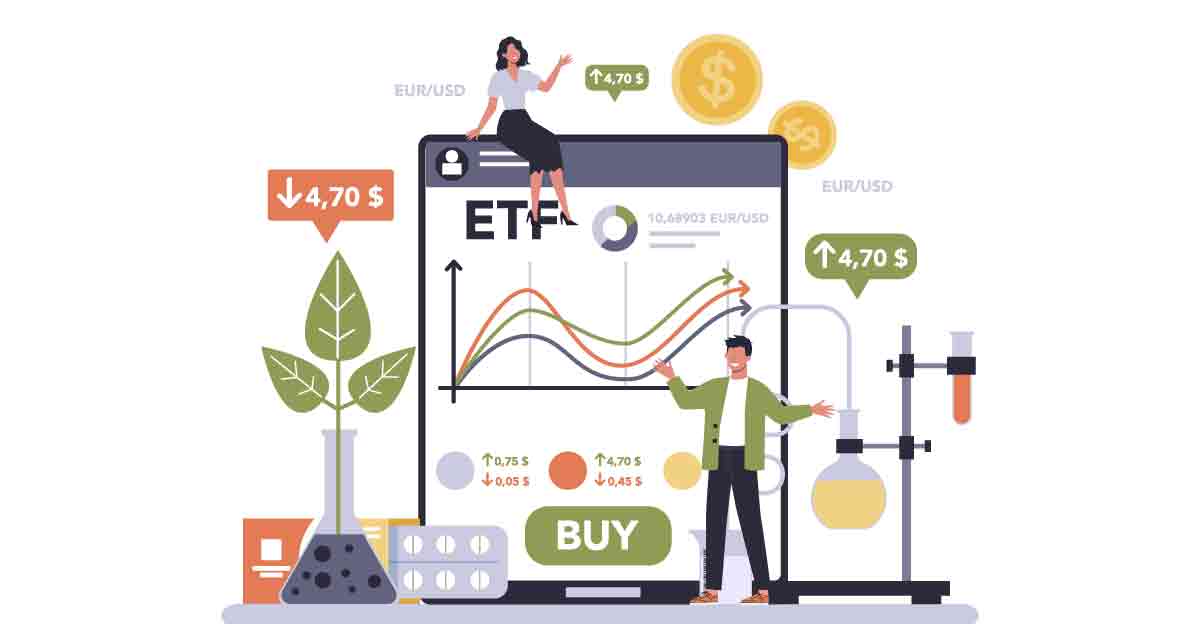Investing in ETFs has gained significant popularity in recent years due to their simplicity, cost-effectiveness, and potential for diversification. Unlike traditional mutual funds, ETFs are traded on stock exchanges, providing investors with the flexibility to buy and sell shares throughout the trading day at market prices.,How to invest in ETF in Zerodha, can be a straightforward process. First, it is essential to understand how ETFs work. Exchange-traded funds in India are investment funds that are traded on stock exchanges, mirroring the performance of a particular index, commodity, or asset class. How to invest in ETF in India through Zerodha, you need to follow a few steps.
To begin, open a demat and trading account with Zerodha, if you haven't already. Once your account is active, you can log in to Zerodha's online trading platform. How to buy etf in Zerodha, Search for the desired ETF using the platform's search function and access its details, including the fund's historical performance, expense ratio, and underlying assets. When you are ready to invest, specify the number of units or the amount you wish to invest in the chosen ETF. Review the order details and place the buy order. The ETF units will be credited to your demat account upon successful execution of the order. It is important to monitor your ETF investments periodically and consider factors such as expense ratios, tracking errors, and overall market conditions.
Investing in ETFs provides an opportunity to diversify your portfolio, access various asset classes, and benefit from market trends. With Zerodha, the process of buying ETFs is streamlined, allowing investors to participate in the growth potential of different sectors and indices in India. Remember to research the ETFs you are interested in, consider your investment goals and risk tolerance, and consult with a financial advisor if needed. By understanding how ETFs work and utilizing platforms like Zerodha, investors can navigate the world of ETF investing in India efficiently and effectively.
Definition of ETFs
Similar to individual equities, exchange-traded funds (ETFs) are investment vehicles that are exchanged on stock exchanges. ETFs pool money from multiple investors and invest in a diversified portfolio of assets, such as stocks, bonds, commodities, or a combination of these. They are designed to track the performance of an underlying index, providing investors with exposure to a specific sector, industry, or market segment.
Benefits of Investing in ETFs
ETFs offer several advantages to investors:
Diversification:
By investing in an ETF, you gain exposure to a broad range of securities, which helps spread out the investment risk.
Liquidity
ETFs can be bought or sold at market prices throughout the trading day, providing investors with liquidity and flexibility
Cost-effectiveness:
ETFs generally have lower expense ratios compared to actively managed mutual funds, making them a cost-effective investment option.
Transparency:
ETFs disclose their holdings daily, allowing investors to know exactly what assets they own.
Tax efficiency:
Due to the unique creation and redemption process, ETFs can be more tax-efficient compared to traditional mutual funds.
Types of ETFs
There are various types of ETFs available in the market, each catering to different investment objectives and strategies. Some common types of ETFs include
Equity ETFs:
These ETFs invest in a basket of stocks, providing investors with exposure to a specific market index, industry, or sector
Bond ETFs:
These funds invest in a variety of fixed-income assets, including corporate, municipal, and government bonds.
Commodity ETFs:
Commodity ETFs track the performance of commodities like gold, silver, oil, or agricultural products.
Sector ETFs:
Sector ETFs focus on specific sectors of the economy, such as technology, healthcare, energy, or financials.
International ETFs:
International ETFs provide exposure to markets outside the investor's home country, allowing for global diversification.
How do ETFs work?

Understanding the mechanics of ETFs is essential before investing in them. Here are the key aspects of how ETFs work:
Creation and Redemption Process
ETF shares are created and redeemed by authorized participants (APs) who are typically large financial institutions. APs acquire a basket of securities that closely resembles the underlying index and deliver them to the ETF issuer in exchange for newly created ETF shares. This process allows the ETF's share supply to increase or decrease based on demand.
Tracking and Underlying Index
ETFs are designed to track the performance of an underlying index, such as the Nifty 50 or the Sensex in the Indian market. The fund manager aims to replicate the index's returns by holding a similar portfolio of securities. This passive investment strategy helps keep the ETF's performance in line with the index it tracks.
Buying and Selling ETF Shares
Investors can buy or sell ETF shares on stock exchanges through brokerage accounts, just like individual stocks. The price of an ETF share fluctuates throughout the trading day based on supply and demand. The market price of an ETF share generally closely tracks the net asset value (NAV) of the underlying securities
Liquidity and Market Making
ETFs offer liquidity to investors because they can be bought and sold on the stock exchange at any time during trading hours. This is possible because there are market makers who provide continuous bids and ask prices for ETF shares. Market makers help ensure that there is a ready market for ETF shares and maintain liquidity by buying or selling shares when there is an imbalance in supply and demand.
Diversification and Cost Efficiency
ETFs provide investors with access to a diversified portfolio of securities in a single investment. By holding a basket of different stocks or bonds, ETFs offer built-in diversification, reducing the risk associated with investing in individual securities. Additionally, ETFs often have lower expense ratios compared to actively managed mutual funds, making them a cost-efficient investment option
Tax Efficiency
ETFs are structured in a way that allows for potential tax advantages. Due to the creation and redemption process, ETFs can minimize capital gains distributions to shareholders. When an AP redeems ETF shares, the ETF can deliver low-cost basis securities, thereby avoiding taxable gains. This structure can make ETFs more tax-efficient compared to traditional mutual funds, where buying and selling by individual investors can trigger capital gains taxes.
Choosing the Right ETF
Before investing in ETFs, it's essential to select the right ones based on your investment goals, risk tolerance, and market outlook. Consider the following factors when choosing an ETF:
Assessing Your Investment Goals
Clearly define your investment goals, whether it's long-term wealth accumulation, retirement planning, or short-term income generation. Different ETFs serve different investment objectives, so align your goals with the appropriate ETF.
Evaluating the Expense Ratio
The expense ratio represents the annual fee charged by the ETF issuer to manage the fund. Lower expense ratios are generally favorable for investors since they reduce the overall cost of holding the ETF.
Analyzing the Underlying Index
Examine the composition of the underlying index the ETF tracks. Understand the sectors, industries, or geographies covered by the index and evaluate whether they align with your investment strategy
Considering Liquidity and Trading Volume
Liquidity refers to the ease of buying or selling an ETF without impacting its price significantly. Higher trading volumes and tighter bid-ask spreads indicate better liquidity, ensuring smoother transactions.
Examining Performance and Tracking Error
Review the historical performance of the ETF, comparing it to its benchmark index and similar ETFs in the same category. Look for consistent performance and a low tracking error, indicating that the ETF closely tracks its underlying index.
Understanding the Investment Strategy
Understand the investment strategy employed by the ETF. Some ETFs passively track an index, while others may have an active management approach. Consider whether the investment strategy aligns with your preferences and risk tolerance.
Considering the Fund Size and Assets Under Management (AUM)
Evaluate the size of the ETF and its AUM. Larger ETFs with higher AUM tend to have better liquidity and tighter bid-ask spreads. They may also have lower tracking errors and lower expense ratios due to economies of scale.
Assessing the Fund Manager
Research the fund manager's track record and experience in managing the ETF. A skilled and experienced fund manager can contribute to the ETF's performance and make informed investment decisions.
Investing in ETFs through Zerodha
Zerodha is one of the leading discount brokerage firms in India, offering a wide range of investment options, including ETFs. Here's a step-by-step guide on how to invest in ETFs through Zerodha:
Opening a Zerodha Account
To use MACD effectively, it's important to customize the indicator settings based on your trading style and the market you're trading. Here are a few considerations:
Understanding Zerodha's ETF Offerings
Zerodha offers a variety of ETFs from different asset management companies. Explore the available ETFs and research their underlying indices, expense ratios, historical performance, and other relevant information.
Placing an Order for ETFs
Once you have identified the ETF you want to invest in, log in to your Zerodha account and navigate to the order placement section. Enter the details of the ETF, such as the quantity and order type (market or limit), and review the order before confirming.
Monitoring Your ETF Investments
After purchasing ETFs, it's important to regularly monitor your investments. Keep track of the ETF's performance, the underlying index, and any news or market developments that may impact your investment.
Tips for Successful ETF Investing
To maximize the benefits of ETF investing, consider the following tips:
Diversify Your Investments
Invest in a mix of different ETFs to diversify your portfolio across various asset classes, sectors, and regions. Diversification helps mitigate risk and enhances the potential for consistent returns.
Stay Updated with Market Trends
Stay informed about market trends, economic indicators, and any factors that may influence the performance of your ETFs.
Rebalance Your Portfolio Periodically
Maintain the proper asset allocation by reviewing and rebalancing your portfolio regularly. Rebalancing involves buying or selling ETFs to bring your portfolio back in line with your target allocation.
Consider a Long-Term Investment Approach
ETFs are well-suited for long-term investment horizons. Instead of trying to time the market, adopt a buy-and-hold strategy to benefit from long-term market trends and compounding returns.
Understand the Expense Ratios
Expense ratios represent the annual fees charged by ETFs for managing the fund. It's important to compare expense ratios across different ETFs and choose ones with lower fees. Lower expenses can have a significant impact on your long-term investment returns.
Consider Tax Implications
Be mindful of the potential tax implications of investing in ETFs. While ETFs generally offer tax advantages, it's important to understand the tax rules specific to the ETFs you own. For example, some ETFs may generate capital gains that could be taxable when sold.
Evaluate the ETF's Liquidity
Before investing in an ETF, assess its liquidity. Look for ETFs with sufficient trading volume and tight bid-ask spreads. Higher liquidity ensures that you can buy or sell ETF shares at competitive prices without significant market impact.
Monitor Tracking Error
Tracking error refers to the divergence in performance between an ETF and its underlying index. A low tracking error indicates that the ETF closely mirrors the index's returns. Monitor the tracking error of your ETFs over time to ensure they are effectively tracking their respective benchmarks.
Regularly Review Investment Strategy
Periodically review your investment strategy and goals. As your financial situation or market conditions change, adjust your ETF holdings accordingly. Consider seeking professional advice when necessary to ensure your investment strategy aligns with your objectives.
Conclusion
Investing in ETFs provides a flexible and cost-effective way to build a diversified portfolio. By understanding how ETFs work, choosing the right ETFs, and leveraging platforms like Zerodha, investors can embark on a successful ETF investment journey. Remember to align your investment goals, stay informed, and periodically review your portfolio to achieve long-term financial growth.





.png)
